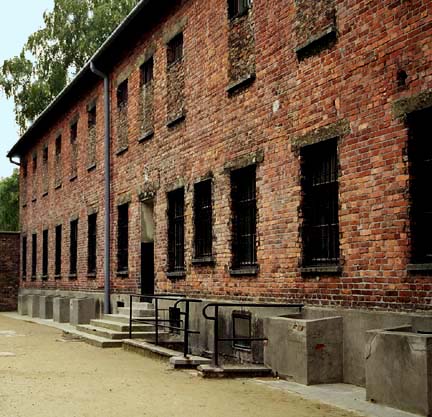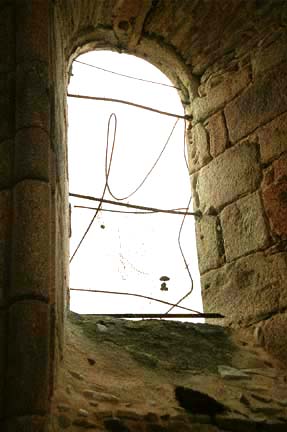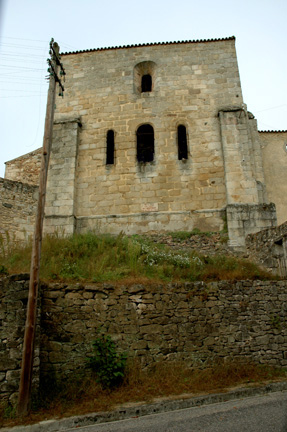Last night, I watched a new TV special entitled “Auschwitz: Hitler’s Final Solution.”
Let me say, right off the bat, the show was not as bad as I was expecting. There were lots of good aspects of the show. For example, the name of the Auschwitz commandant, Rudolf Höss was pronounced correctly. (It sounds something like “Hearse.”)
Since the title of the show included the name Auschwitz, not Auschwitz-Birkenau, I was expecting the show to be about the main Auschwitz camp, but the show started off by showing aerial footage of the huge 425 acre Birkenau camp with it’s huge number of wooden barracks, as the narrator told us that 1.1 million people had died at this place. This indicates that this show was made recently, since the number of deaths is now down from the original 4 million, that was claimed at the Nuremberg IMT, to 1.1 million, claimed by the current official Auschwitz website.
Then we see the railroad tracks on the inside of the Birkenau camp with the Gate of Death faintly shown in the background.
Finally, we get to the start of the show, which is labeled “Origins – April 1940”. So it turns out that the show is going to be about the main Auschwitz camp where Rudolf Höss was the first Commandant. We see a shiny black car, traveling towards us, on what looks like a dirt road. I think that this scene is authentic because, when I first went to Poland in 1998, the roads looked a lot like this.
One of the best things about the show is that Rudolf Höss is humanized. One scene shows him getting his hair cut by a prisoner who says, on the show, that he could have easily slit the Commandant’s throat, but it would have meant his own death, and the new Commandant could have been worse.
At the very end of the show, Rudolf Höss is shown as a loving father, sitting around the fire, with his arms around his children. That’s how one of his daughters has described him. How could such a nice man have killed all those Jews. Stay tuned for more.
Color photos are shown of the red roof tops of the barracks buildings in the main camp, as we are given the first mistaken information about the main camp. We are told that these building date back to 1940, when the main Auschwitz camp was “a former Polish Army barracks.” We are told that the main camp was “not for Jews, but for “Polish political prisoners.” Close, but no cigar. The main camp was first used for illegal combatants, who were fighting as “resistance fighters.”
But to get back to the origins of the main Auschwitz camp, it was built as a camp with barracks for farm workers who stayed there between jobs, and traveled by train to work on farms throughout Poland.
Auschwitz was the main railroad hub in Europe. From Auschwitz, a person could go anywhere in Europe, without changing trains. I wrote about this on this previous blog post: https://furtherglory.wordpress.com/2014/05/16/why-auschwitz-was-chosen-by-the-germans-as-the-location-of-their-largest-camp/
As the show continues, we learn that “in 1940, the motto of Dachau was put over the gate into the main Auschwitz camp.” Of course, we are not told the real meaning of this slogan and why it was put on the main Auschwitz camp, but not on the gate at Birkenau. I wrote about the meaning of the “Arbeit Macht Frei” sign on this blog post: https://furtherglory.wordpress.com/2010/02/25/arbeit-macht-frei-what-does-it-stand-for/
It is not long before the show gets to the first big lie: a fake photo of “pole hanging.”

This photo is a still shot from a film made by the Soviet Union
I took the photo above in the Museum at Dachau in May 2001. The photo, which is a depiction of the alleged tree hanging punishment at Buchenwald, was not included in the new Museum at Dachau which opened in May 2003.
According to Harold Marcuse, Professor of History at the University of California at Santa Barbara, this scene was created in 1958 for an East German DEFA film, which is why the photo is no longer used. Reference: H. Obenaus, “Das Foto vom Baumhängen: Ein Bild geht um die Welt,” in Stiftung Topographie des Terrors Berlin (ed.), Gedenkstätten-Rundbrief no. 68, Berlin, October 1995, pp. 3-8.
Right after the fake photo is shown, we see some photos of the house where Rudolf Hoess lived. Then, after a commercial, we see the red roofs of the main camp again. We are told that Auschwitz was located in an area where there was lots of coal, and that the IG Farben company needed coal for their factories where synthetic rubber was being made. We are told that Heinrich Himmler visited the town of Auschwitz, and that the residents were thrown out so that Germans could take over the town.
According to this show, Hitler wanted to “reshape entire countries.” We are told that Hitler thought that the Russians were “inferior human beings” and that he was “planning mass starvation in the Soviet Union.” We are told that “the Nazis envisioned the extermination of 3 million Russians in the Soviet Union.”
Then we get to the crux of the matter: “The Jews had lost World War I for Germany.” I believe that this is correct. Hitler turned against the Jews because he believed that they were the cause of Germany losing World War I.
We were shown photos of Jews being beaten in Ukraine. We were told that 10,000 Jews were gathered in Ukraine and then taken out and shot. We are shown the footage of the dead Jews falling into ditches as they are shot. But the narrator says: “the Jews cheated the Germans.” At last, a reason for why the Germans killed the Jews. I never thought that I would ever hear that on TV.
As we see film footage of the survivors of Birkenau marching out, we hear that we are usually told that the Jews were killed for no reason, but a former German soldier, who is on the show, says that “they were killed for a reason.”
I thought that the show would never get around to the gas chambers, but finally the big day arrives and we hear that it was in the Summer of 1941 that prisoners were first “killed by gassing.”
At that point, I thought that we would see a photo of the gas chamber in the main Auschwitz camp, but no, we are told that the gassing started with the “gibbering idiots” and “disabled children” and was then extended to “disabled adults”.
I thought that, at this point, we would see a photo of the gas chamber at Hartheim castle, but no! We are told about another place, that I have never heard of, where the “disabled were sent into a shower room,” and “carbon monoxide was turned on.”
We are told that “the first Auschwitz prisoners were sent to Germany to be gassed, and that these were “worn out prisoners who could no longer work.” Unfortunately, the location of the gas chamber in Germany was not mentioned.
Finally, we get to the first gassing at Auschwitz. This was the experiment that was allegedly done in Block 11 in the main camp. It was mentioned that “the windows were blocked with sand.” I have written about this on my website and on this blog post: https://furtherglory.wordpress.com/2013/03/16/the-first-gassing-of-prisoners-by-the-nazis-took-place-in-block-11-at-auschwitz/
The detail about the window being blocked with sand makes me think that this story is a lie. I don’t think that any German person would ever do something like that. It would have been difficult to get the sand out of the window well, although not impossible.

Block 11 had window wells around the basement windows
Finally, the show gets around to the first homicidal gas chamber where Jews were killed in the Holocaust. I thought that we would see some photos of the inside of the gas chamber in the main Auschwitz camp, but no! All we see is a photo of the door into the gas chamber, similar to my photo below.

Door into the gas chamber in the Auschwitz main camp
Why can’t we see a photo of the gas chamber in the main camp? Is it because people in the audience would die laughing?
Then we see a photo of two ovens in the gas chamber building, but no photo of the gas chamber room. The photo of the ovens was similar to my photo below.

A photo of the ovens in the main Auschwitz camp was shown in the documentary
During the show, there were extensive quotes from the confessions of Rudolph Hoess, but there was no mention that these were confessions obtained by many days of British soldiers torturing Hoess. I have quoted his confessions on this page of my website: http://www.scrapbookpages.com/AuschwitzScrapbook/History/Articles/RudolfHoess.html

Rudolf Hoess appears to be afraid of the nice British officer
It should have been explained in the show that Rudolf Hoess confessed after many days of being kept awake and tortured. The photo above shows that he is afraid of the British officer who is talking to him. However, the words from his confession were quoted in the show, as the absolute truth, without saying that these were the words of Rudolf Hoess after many days of torture.










































